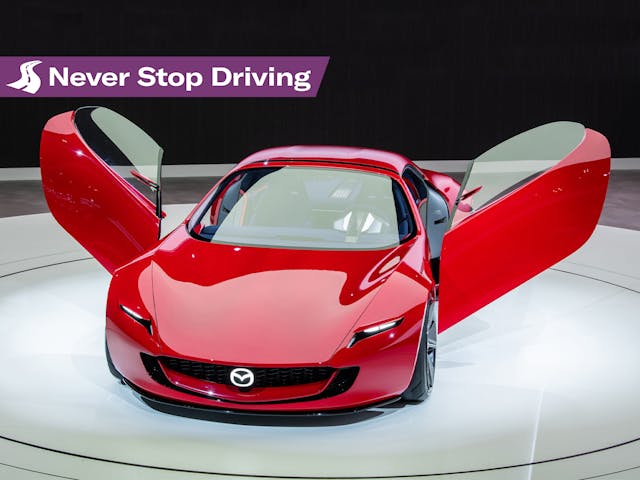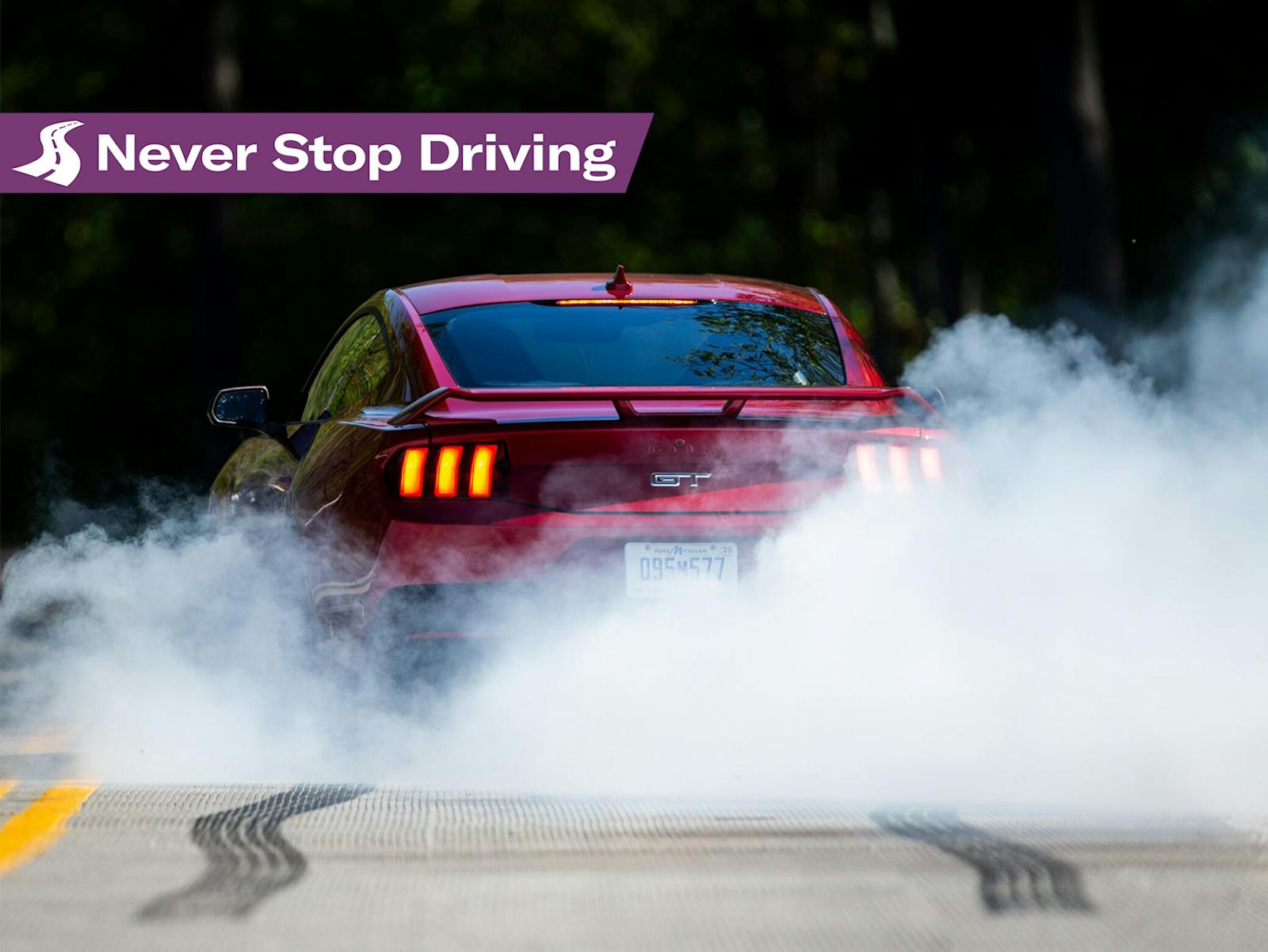Never Stop Driving #73: The fun is back
We thought the auto show was dead or at least in hospice. The events that once hosted glamorous new-car debuts and dreamy concept cars have largely devolved into indoor dealer parking lots. There’s nothing wrong with that, of course, since a place where buyers can peruse all car brands in one setting is a terrific convenience. Still, I miss the show biz aspect of the big global auto shows and therefore am glad to hear that it was back at last week’s Tokyo Mobility Show.
The event, which used to be called the Tokyo Motor Show, has long been a venue for the weird and fantastic, and it continued that tradition with cars like the Nissan Hyper Tourer. There was plenty of talk about electric powertrains, but there were also plenty of sporty cars. Honda showed a possible future Prelude, Toyota teased a potential new MR2, and Nissan went hyper-aggressive with the wonderfully named Hyper Force. My favorite was the Mazda Iconic SP, a sports coupe concept with a rotary engine that spins a generator to power the electric drive motor. Ignore the powertrain and that car could be the next Miata. I’m just geeked that Mazda’s thinking about the next one.
It’s heartwarming to see that the industry still has a pulse for creativity and enthusiasm. During the show, Toyota chairman Akio Toyoda reiterated his EV skepticism. When asked about softening EV demand in the U.S., Toyoda said, “People are finally seeing reality.” In other recent major, EV-related announcements, General Motors and Honda scrapped plans to co-develop affordable EVs, a partnership that’s just over a year old, and Ford said it would delay about $12 billion in EV spending.

Meanwhile Cruise, GM’s autonomous car company, responded to the recent banning of its driverless cars in California by announcing that it would no longer operate its vehicles without a safety driver behind the wheel. I still think that EVs and autonomous cars will transform our roads, but that evolution seems further away every day. The brightest news in the EV space is that Tesla says it will deliver the first Cybertruck this month. I’m no fan of the design, but I’ve heard a few engineering tidbits that have made me curious about the vehicle’s details. We’ll learn more as the month unfolds.
The big buzz in the auto industry over the past six weeks has been the UAW strike, which ended. The union scored wage increases and a shorter path from starting to full pay. The perception is that the UAW won, which was underscored by how the stock prices of all three companies fell right after the strike ended. Wow. UAW president Shawn Fain played the PR game well, wearing an “Eat the Rich” T-shirt during one of his videos. Even the Wall Street Journal, usually no friend to Big Labor, ran this headline: “Auto Company CEOs Make 300 Times What Workers Make.” That disparity is, I think, fueling labor’s reawakening.
It remains to be seen whether the UAW’s win will help it unionize factories run by Tesla and foreign company transplants like BMW and Honda, which now have a wider labor-cost advantage. Will the non-union workers see not just the UAW gains, but also the increases the Teamsters scored at UPS, and decide they need a union too? These things happen in waves, as union power ebbs and flows. I think it’s coming back and that pay gap is a major reason.

I’ve seen highly paid execs, like Bob Lutz at Chrysler and later GM, who are very effective, transform companies in positive ways, and are worth every penny they’re paid. I’ve also seen plenty of bulls*** artists in the executive ranks. CEO pay is complicated because it’s so often tied to performance: If the company does well, so do the leaders. It’s hard to argue with that. That said, U.S. auto CEOs are more generously compensated than foreign peers. According to this article, Akio Toyoda made just under $7 million in 2022 compared with GM’s Mary Barra’s nearly $30 million take-home. Entrepreneur and NYU business professor Scott Galloway provided a good explainer on the complicated topic here.
Let’s get back to cars. The auction for my 1986 Ford Mustang closes today and I’ve greatly enjoyed the discussions about it. Thanks to all of you who visited the listing. I’ve sold a lot of cars, and the best part is seeing another person experience the same joy with the car that I did. I’m hoping for that outcome today. There are no plans for a replacement, but after reading this article about the curse of the yellow Honda CRX, I’m jonesing for one. Get all of Hagerty Media material delivered right to your email inbox by signing up for our newsletters here.
Have a great weekend!
P.S.: Your feedback is very welcome. Comment below!
Please share this newsletter with your car-obsessed friends and encourage them to sign up for the free weekly email. The easy-to-complete form is here. And if you’d like to support the efforts of Hagerty Media, please considering joining the Hagerty Drivers Club.



Larry, when your 1986 Mustang GT sells, we’d love to know what the selling bid is/was. Thanks much!
Yeah for sure!
Well lets not get to far ahead in the good times are back thinking. There is still a lot in play and still has to happen.
#1 these show cars sound cool but with the economy not all that great and two major wars going on I expect companies to be a bit conservative for now.
Lower priced sports cars are often low profit. Even the last Miata needed a Fiat partner to share the cost. Lets watch what happens.
The Automakers are now finding the cost of batteries getting cheaper has slowed. This has has been a problem since Covid. I expect the automakers to make this a part of the presidential campaign to try to slow the federal rules and buy time.
The real problem are the 14 or so CARB embracing states that are not as inclined to give more time. They account for about 44% of the market. This may be a problem.
The Unions are not going to make inroads in the south. They are despised and are seen as taking money from the employees. Southerners tend to be more self reliant and not group think.
As for the CEO. Yes it is about performance. Mary’s pay is $2.1 million and what the rest was mostly bonuses based on stock value. If she cashed out yes it was $30 Million but if it drops next year it could be $500,000.
She has played a fair game at GM in some very difficult times. While not every one is happen and never will be she has kept GM on the path and done better than many that proceeded her.
Now Ford is the one that is of concern. With stock in the tank and other issues how long till the Ford family bails on the companies 51%?
At one time the Ford Motor company was their leading company and now it appears the Lions have taken that place.
It is only going to get tougher at Ford and their leadership is not getting it done.
Good Luck on the Stang.
Don’t get me started. Performance incentive are everything that is wrong with American industry. How can your goal be to lead an industry in the next decade, when you pay your execs based on bumping stock prices. And do stock prices reflect the health of a company? Not really. It may just mean thet they’re being bought out next week by corporate raiders. There are MANY columns left in the topic” How screwed up is the US auto industry?”
This is the deal you pay them based on performance but the board still has to judge that. It is not just lets boost the stock for now. That stock has to stay up to be worth anything and a company needs to remain healthy and relevant.
On the other hand you have no incentives you end up with a guy that is not going to do much. You still pay a lot of money and no results
If not for the Ford family owning 51% they may have been bought out with their stock below $9 so often in the last few years. All the while Farley is out racing his car.
The fact is if the CEO is going to be there they need to keep the company healthy if they are going to make any money that is lasting. Few go selling the stock as long as they are there.
Much anymore is trying to control debts and keep product moving while investing in the future.
Todays American automakers are struggling with debit at Ford and with how to invest in the future with the government forcing crazy regulations that are just easily met.
EV neet more work and Hybrids are still not the answer. Remaining with ICE is tough as we are already seeing most vehicles going to 3 cylinder engines. We can only cut so many cylinders.
To be honest being an Auto CEO is one of the toughest jobs out there.
I agree that unions are on the upswing and the extremely high pay of executives is a big part of the reason. I have had a love/hate relationship with the UAW for a long time. I have seen them make, and receive ridiculous demands. I have worked as a non union GM contract employee in a UAW run facility and seen union members at their worst. This time around, I support them 100%. The union gave up a lot back around 2009 when the auto companies were teetering on the brink of bankruptcy and they have gotten very little back. The executives, Mary Barry and her cohorts, have been making money hand over fist. It’s time for the workers to get their share.
The obvious economic fact about EVs is that A) no one but Tesla has built out the necessary infrastructure that is necessary to get most people to be comfortable buying them and B) the promised less-expensive EVs are not materializing as promised. Of course they aren’t selling!
My first car was a 1966 Mustang 289 notch-back I bought in 1975. I’m a long-time car guy. I was lucky enough to swing a used 2015 Tesla Model S 85D in April 2017 — not because I’m a “greenie” (though, I do consider myself reasonably ecology-minded), but because the car was beautiful, drove like a dream, and was very inexpensive to operate. I drove it for six years and 100,000 miles. It was probably the best overall vehicle I’ve ever owned.
We should NOT be told what kind of cars to buy. EVs (and other alternative fuel cars) will earn their way into our garages and driveways on their own merits when automakers finally figure out how to earn our business with them. There may be a case for government assistance building infrastructure for more environmentally-friendly cars, but mandates are oppressive and unnecessary.
Regarding autonomous vehicles, well, I guess they have their place — especially for those who commute. But I pray we never give up the ability in our country to jump in our own vehicle and enjoy the thrill of pointing it to whatever destination we choose, whenever we want. I am totally onboard with “Never stop driving!”
Taste is interesting. I don’t see the Tesla model S as “beautiful”. Certainly not remarkably more beautiful than a 2002 Pontiac Grand Prix. Now, I like many of the later-generation Pontiac designs with their athletic sportiness hints compared to some of the terrible bland competition in the segments. So the S is a good design to my eyes.
The Tesla Roadster is more of a standout, but based on price point alone it should be.
Many of other Tesla models (not even referring to the polarizing Cybertruck) have goofy proportions and are unbeautiful, despite what the internet seems to want us to believe.
“If the company does well, so do the leaders. It’s hard to argue with that.”
Agreed, but I will add what’s good for the goose is good for the gander; i.e. the rank and file – the folks actually making that increase in performance happen – should share in those incentives and receive exactly the same proportionate stock options as Ms. Barra.
Regarding autonomous vehicles; my daughter worked at a start-up whose products and services support the AV sector and she was skeptical about seeing true Level 5 autonomy in her lifetime….and she’s only 30 years old!